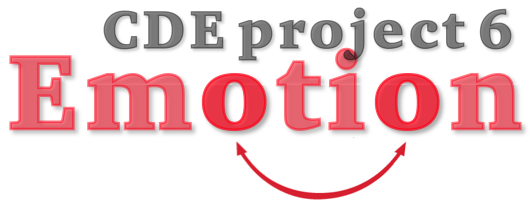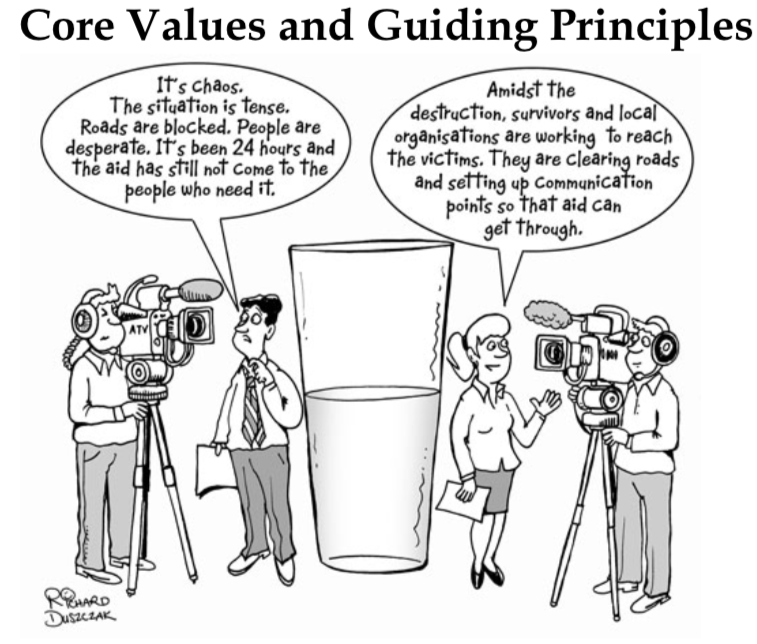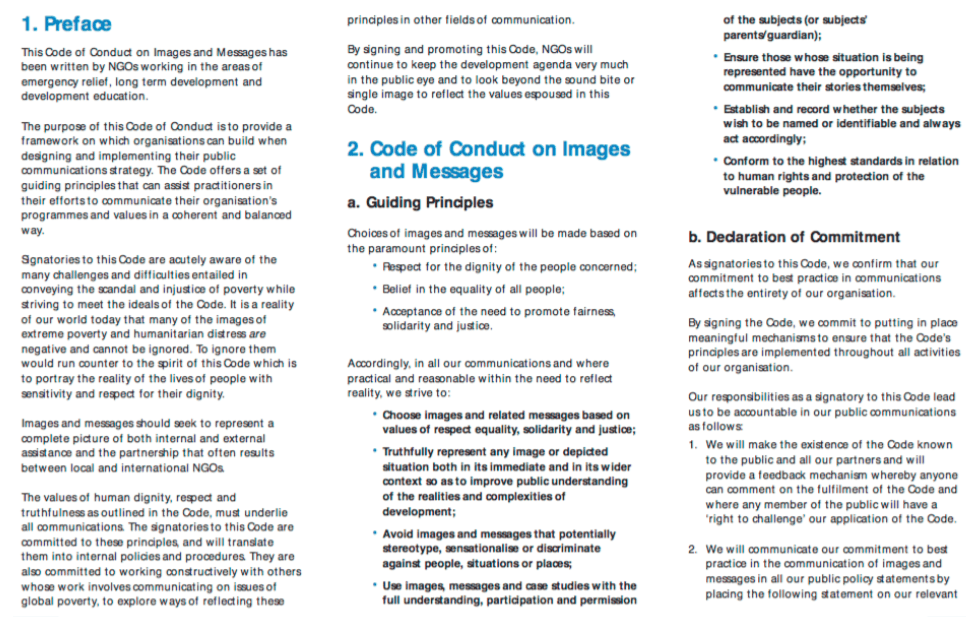CDE project 6 section 4.5c: The Dóchas code of conduct on images and messages.
In an excerpt from his landmark book Relationship Fundraising, Ken Burnett explores the The Dóchas code of conduct on images and messages and why it is a necessary guide to how charitable organisations should operate.
- Written by
- Ken Burnett
- Added
- January 24, 2019

The use and misuse of emotion. Section 4: emotions and donors. 4.5c
The Dóchas code of conduct on images and messages.
And why we might need it.
By Ken Burnett
Two memories relating to the use and misuse of images stand out from my early days as a fundraiser. These paragraphs are taken from my 1992 book, Relationship Fundraising.
The story of Mbazimutima
In my country parental permission is necessary before any photographs of children are reproduced, so signed approval should always be sought. No such regulations protect the image of the Third World child. Any chance of protection is left in the gentle hands of the fundraiser. Which brings me to Mbazimutima.
When I was a fundraiser at ActionAid (one of the UK’s largest development charities) we recruited supporters via newspaper advertisements in the quality press. Because it was a relatively expensive exercise we were always testing – different copy, different sizes, different media – and our tests were rigorously scientific. We used photographs of African or Indian children waiting to be sponsored. As soon as one child was sponsored, we changed the photograph. No permission for this had ever been sought or given, but we had no complaints, mainly I suppose because the parents of these children weren’t likely to read the newspapers in which we advertised.
One evening I was asked to approve a rush proof of an A/B split copy test we were running (a facility where two same-size versions of our ad appear in the same issue of a newspaper by being printed on different presses but mixed equally before distribution, thereby giving a valid split test). The only change in this particular test was in the child used. The relative pulling power of different children was being tested. Now there’s nothing wrong with that. We all know that we need to use attractive, appealing images in our ads. In this respect charities are no different to washing powders. But one of my colleagues noticed that the picture which was captioned Mbazimutima, aged eight, Burundi, wasn’t him. Someone at the agency or the newspaper had used the wrong picture. I was very new at the time and was under some pressure from the newspaper and the agency to approve the ad quickly. No one would know the difference. If Mbazimutima’s replacement was to walk down London’s Oxford Street, no one would know he was the wrong guy.
We discussed it and agreed that whatever the consequences we would change the picture so the right name would appear under the right photograph. So Mbazimutima’s name appeared under his photograph, as he would have a right to expect. I am sure that was the correct thing to do. As fundraisers we must never forget that we are dealing with real people who, if they were given the chance, would care about what we do with their image.
The fundraiser’s awesome responsibility
I once sent a photographer to India to document development work in Kerala. He came back with many stunning images but one of a ragged-haired, wide- eyed naked boy was particularly dramatic and appealing. I used his picture in a poster campaign and wrote a headline, which was set across his lower torso thereby covering his dignity. I never had his permission but it was a popular poster and made him famous across the UK. I don’t suppose he ever knew.
Later our advertising agency selected the same picture for another national poster campaign, but here the headline wasn’t so obliging and we had the problem of deciding whether or not to run a poster that showed in full a naked boy. I was very much against it, but was persuaded that rather than replacing the photograph, which wouldn’t be easy, it could be retouched to remove effectively the offending part by blurring the image at the appropriate spot. In the end the retoucher transformed our stunning little boy into a no less beautiful and appealing little girl. But we had no right to do this and I have regretted it ever since.
My excuse that this was a very long time ago doesn’t really stand up. Fundraisers for overseas causes have an awesome responsibility and not all of us discharge it faultlessly. When UK charities such as the National Society for the Prevention of Cruelty to Children (NSPCC) and Action for Children use images of children they have to employ models. These can then be art directed and made up as required and the public readily understands the need to protect the identity of the real cases. These charities’ promotions are no less effective because of it.
Shortly after the above incidents I wrote a piece in the UK, suggesting that similar rights and protection should also be given to people from other lands and cultures. It was and still is a grey area for fundraisers. I suggested that yet another code of practice should be devised to allow fundraisers to portray legitimate emotional images without demeaning, exploiting or misleading either the public or the people whose images are being used but who can’t give permission and can’t protect themselves.
That’s how I came across the Dóchas code. https://goo.gl/ULrGa6
Find out what the Code is all about and why it matters in this animation on YouTube:
Background to the Code of Conduct
In 2007, Dóchas members adopted a Code of Conduct on Images and
Messages. The purpose of this Code is to provide a framework which
organisations can refer to when designing and implementing their public
communication strategy.
The Code offers a set of guidelines to assist organisations in their decision- making about which images and messages to choose in their communication while maintaining full respect for human dignity.
By signing the Code, Development NGOs commit to a set of principles, ensuring that they will avoid stereotypical or sensational images. The adoption of the Code means that aid agencies will choose images and messages that represent the full complexity of the situations in which they work, and that they will seek the permission of the people portrayed in the photos they use.
• Access useful Code resources
• Find out which organisations are signatories to the Code
• Read resources on Images & Messages and Development

The Code of Conduct’s guiding principles stipulate that ‘choices of images and messages will be made based on the paramount principles of:
• Respect for the dignity of the people concerned;
• Belief in the equality of all people;
• Acceptance of the need to promote fairness, solidarity and justice.
Accordingly, those following the code will, in all their communications and where practical and reasonable within the need to reflect reality, strive to:
-
Choose images and related messages based on values of respect equality, solidarity and justice;
-
Truthfully represent any image or depicted situation both in its immediate and in its wider context so as to improve public understanding of the realities and complexities of development;
-
Avoid images and messages that potentially stereotype, sensationalise or discriminate against people, situations or places;
-
Use images, messages and case studies with the full understanding, participation and permission of the subjects (or subjects’ parents/guardian);
-
Ensure those whose situation is being represented have the opportunity to communicate their stories themselves;
-
Establish and record whether the subjects wish to be named or identifiable and always act accordingly;
Conform to the highest standards in relation to human rights and protection of the vulnerable people.
Signatories to the Dóchas Code of Conduct on Images and Messages are obliged to ensure that: the materials and communications they produce are in-keeping with the principles as set out in the Code; and to provide the public with a facility to feedback, both positively and critically, on these communications.
The organisation’s feedback mechanism is to be the first point of contact for those who wish to make a complaint. However, in the case where an organisation fails to respond or where their response is not deemed satisfactory by the complainant, they may choose to initiate a complaints process through Dóchas.
© The Commission on the Donor Experience 2018


















